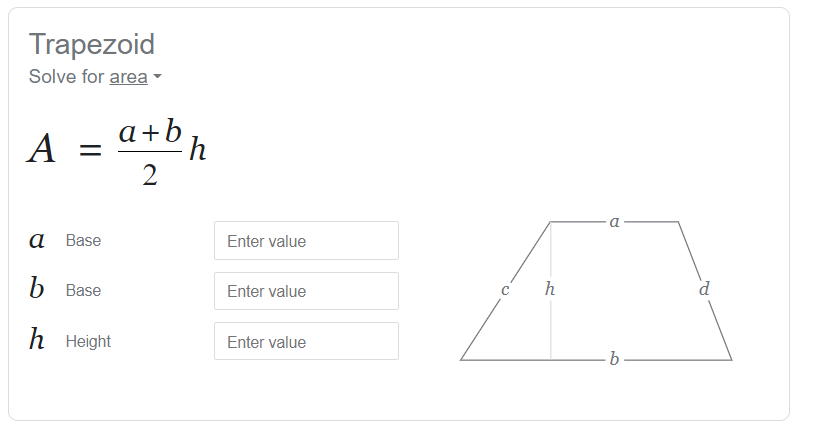Table of Contents
Area of Trapezium
It is a region covered by a 2-dimensional shape in a plane. It is the space enclosed in 2D geometry and measured in square units (like cm2, m2, in2, etc). Alike other geometrical shapes, Trapezium also has its own properties and formulas based on area and perimeter. Hence, the area of the Trapezium formula is explained below along with its derivation and examples to make you understand better.
Let us see the formula to understand how to calculate the area of the Trapezium.
Area of Trapezium Formula
Trapezium area can be calculated by using the below formula:
Area of Trapezium = 1/2 x distance between the parallel sides x Sum of parallel sides
Area = 1/2 x h x (AB + DC)
Where,
“a” and “b” are the bases, and
“h” is the altitude or height or distance between parallel sides.
Perimeter of Trapezium
The perimeter of a shape is defined as the total length of its boundary. The perimeter of a shape is determined by adding the length of all the sides and edges enclosing the shape. It is measured in linear units of measurement like centimeters, meters, inches, or feet.
The perimeter of the Trapezium can be calculated by using the mentioned formula:
Perimeter = Sum of all the sides = AB + BC + CD + DA
Trapezium
The area of Trapezium is a region covered by a 2-dimensional shape in a plane. A quadrilateral with at least one pair of parallel sides is called, in American and Canadian English, a Trapezoid. In British and other forms of English, a Trapezoid is called a Trapezium. It is a quadrilateral with exactly one pair of opposite sides parallel to each other and the other pair of a Trapezium are non-parallel. Euclidean Geometry defines a quadrilateral as a polygon with four sides and four vertices. When the trapezium is drawn it suggests a desk or a triangle, this is reduced from the top.
In the above figure, Sides AB and CD are parallel to each other (bases) whereas AD and BC are non-parallel sides (legs) and h denotes the height between two parallel lines.
Types of Trapezium
Types of Trapezium The trapezium is divided into 3 distinct classes as mentioned below:
- Isosceles Trapezium
- Right Trapezium
- Scalene Trapezium
Isosceles Trapezium :
It can be defined as a Trapezium in which both legs and base angles are of the same measure.
Right Trapezium :
A right Trapezium is a Trapezium having two right angles.
Scalene Trapezium :
A scalene Trapezium is a Trapezium with no sides of equal measure.
Properties of Trapezium
Every Trapezium has the following properties:
- One pair of opposite sides are parallel.
- The two non-parallel sides are unequal except for the isosceles Trapezium.
- Two pairs of adjacent angles add up to 180 degrees.
- The diagonals intersect.
- The line that joins the mid-points of the non-parallel sides is always parallel to the bases or parallel sides which is equal to half the sum of the parallel sides
- The sum of the four interior angles is 4 right angles, i.e. 3600.
- The sum of the four exterior angles is 4 right angles, i.e. 3600.
Trapezium Formula
The formula for the area of a trapezium (trapezoid) is:
Where:
is the area of the trapezium.
is the length of one of the parallel sides (the “top” or “bottom” side).
is the length of the other parallel side.
is the height (perpendicular distance) between the two parallel sides.
You can use this formula to calculate the area of a trapezium when you know the lengths of the two parallel sides and the height.
How to Find Area of Trapezium
Here we will learn how to derive the formula to find the area of the Trapezium.
Area of Trapezium ABCD = Area of ∆ ABD + Area of ∆ CBD
= 1/2 × a × h + 1/2 × b × h
= 1/2 × h × (a + b)
= 1/2 (sum of parallel sides) × (perpendicular distance between them)
How to Find Area of Trapezium: Step-by-step process from Formula
Step 1: Find the dimensions of the given Trapezium, i.e., length of parallel sides and length of height.
Step 2: Add the length of parallel sides
Step 3: Multiply the sum of parallel sides with the height of the Trapezium
Step 4: Now, multiply the above-calculated value by 1/2 to get the final answer
The obtained value in step 4 is the area of the given Trapezium.
Some examples are given below for a better understanding of how to find out the area of the Trapezium.
Area of Trapezium- Uses
A Trapezium is a four-sided polygon. A Trapezium is having many applications in our daily life. In daily life, we can see the Trapezium shapes in the tabletops, bridge supporters, and architectural elements, in windows, doors, and in pencil boxes, handbags, etc. The concept of the Trapezium is used in physics to solve many problems. In mathematics, solving problems based on surface area or for finding the area and perimeter of complex figures. The formula of the Trapezium is used in the construction of the shape of the roof. A Trapezium has various applications in day-to-day life.
Area of Trapezium Formula Example Problems
Here, some questions are given below which will clear all your confusion.
Question 1:
Find the area of a Trapezium whose parallel sides are 24 cm and 20 cm and the distance between them is 15 cm.
Solution:
Given,
a = 24 cm
b = 20 cm
Distance between two parallel sides, h = 15 cm
Area of a Trapezium =1/2×(Sum of parallel sides)×(Distance between them)
={1/2×(24+20)×15} cm2
=(1/2×44×15) cm2
=(22×15) cm2
=330 cm2
Hence, the area of the Trapezium is 330 cm2.
Question 2:
What is the area of a Trapezium when bases are 12 cm and 20 cm respectively and the distance between the two parallel sides is 10 cm?
Solution:
Given,
a = 12 cm
b = 20 cm
Distance between two parallel sides, h = 10 cm
Area of a Trapezium =1/2×(Sum of parallel sides)×(Distance between them)
{1/2×(12+20)×10} cm2
=(1/2×32×10) cm2
=(16×10) cm2
=160 cm2
Hence, the area of the Trapezium is 160 cm2.
Area of Trapezium Formula Practice Questions
- Find the area of a Trapezium whose lengths of parallel sides are 10 cm and 6cm, respectively and the distance between the parallel sides is 5 cm.
- If the area of a Trapezium is 728 cm2. Find the height of the Trapezium such that the lengths of its parallel sides are 16 cm and 7 cm, respectively.
- The area of a Trapezium is 384cm². If 3:5 is the ratio of the length of its parallel sides and the perpendicular distance between them is 12 cm. Find the length of each of the parallel sides.
Related Post:
- National Flag Of India Name Is Called Triranga
- Newton’s Laws Of Motion- Examples For Kids
- Simple Microscope Diagram, Formula, Definition, Discoverd By And Magnifying Power
- Laws Of Motion- First, Second, Third Law With Applications
- Fleming’s Left Thumb Rule Used For
- Uidai.Gov.In Aadhar- New Registration, Update, Download For School
- States And Union Territories Capitals Of India 2022
- Emergency In India And Its Impact
- Cube Formula- Volume, Surface Area In Maths For Class 10
- Water Cycle Diagram For Kids Of Class 3 With Explanation
- 1 To 30 Square And Cube [ PDF Download ]
- Trigonometry Table (0 To 360): Formula, Value, Chart, Ratio, PDF For Class 10





 JAC 10th Result 2024 Link Active, Check ...
JAC 10th Result 2024 Link Active, Check ...
 Importance of Education Essay- What is E...
Importance of Education Essay- What is E...
 JAC 10th Toppers List 2024 Out, Jharkhan...
JAC 10th Toppers List 2024 Out, Jharkhan...














